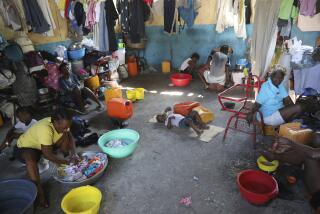Niger Says 1.3 Million May Face Hunger Due to Worst Grain Crop Since ’84 Famine
- Share via
NIAMEY, Niger — An estimated 1.3 million people in Niger could go hungry by spring because of the nation’s worst grain harvest since the famine of 1984, the government says.
The government is reporting a grain shortage of 274,000 tons, meaning that about 20% of Niger’s 6.7 million people will not have enough to eat.
Donor agencies, however, contend that the shortage is less than half the amount reported by the government. And they say the dispute over the numbers threatens to hold up foreign aid until it is too late.
“What happens this spring depends on settling the dispute between now and the end of the month,” said Jim Atkinson, coordinator of food assistance for CARE, adding that food shipments take three or four months to reach landlocked Niger.
Atkinson, who did relief work for Sudan’s famine in 1984, is not optimistic.
“It will be the same as it always is, a delayed response to an emergency,” Atkinson said. “We’re holding our breath.”
U.S. Ambassador Richard W. Bogosian is more hopeful, however. He said the government and donor agencies will eventually agree. Meanwhile, he has requested 10,000 tons of U.S. emergency food aid.
“Under the best of circumstances in Niger you are always on the knife edge of agricultural disaster,” Bogosian said. “And this spring, by April or May, things could get very rough.”
Echoing comments heard from most aid experts in Niger, Bogosian said that a bright spot is Niger’s experience in distributing food relatively efficiently and honestly in the 1984 crisis.
Michael Kerst, drought relief officer with the U.S. Agency for International Development in Niamey, said the differences between the government and donor estimates of the shortage stem from the difficulty in compiling reliable statistics.
“It’s embarrassing how much we don’t know,” he said.
Donor agencies say the relatively good harvests of the last two years should have left the country with a grain surplus of 200,000 tons. But the government says it had to use the surplus to help pay the country’s foreign debt.
Farmers are reluctant to disclose how much they produce in the belief that the more they grow, the less return they will receive.
A team of experts from the United Nations Food and Agricultural Organization is surveying the countryside in hopes of gathering accurate harvest figures, which would settle the dispute.
Adding to the confusion is the pattern of last fall’s rains.
“You could have rain and good crops on one side of a village this year and drought on the other,” Kerst said.
Niger is in the Sahel, a semi-arid region that extends across northern Africa from Senegal in the west to Ethiopia in the east.
Niger gets help from France, the United States, Canada and West Germany, the United Nations and a variety of private agencies which, in 1984, helped cover a shortage of 700,000 tons of grains.
“In many respects ’84 was an easier situation than this year,” Kerst said. “Then you could see the famine coming and you knew it was nationwide in scope. All you had to do was blanket the country in sorghum and millet.
“Now we have to fine-tune distribution, because if you dump a lot of food where it isn’t needed, market prices tumble and the aid undermines the incentive of farmers to plant for next year.”
Niger won the praise of donors four years ago for the way it distributed food to remote villages connected by few roads throughout the nation, which is the size of California and Texas combined.
More to Read
Sign up for Essential California
The most important California stories and recommendations in your inbox every morning.
You may occasionally receive promotional content from the Los Angeles Times.













